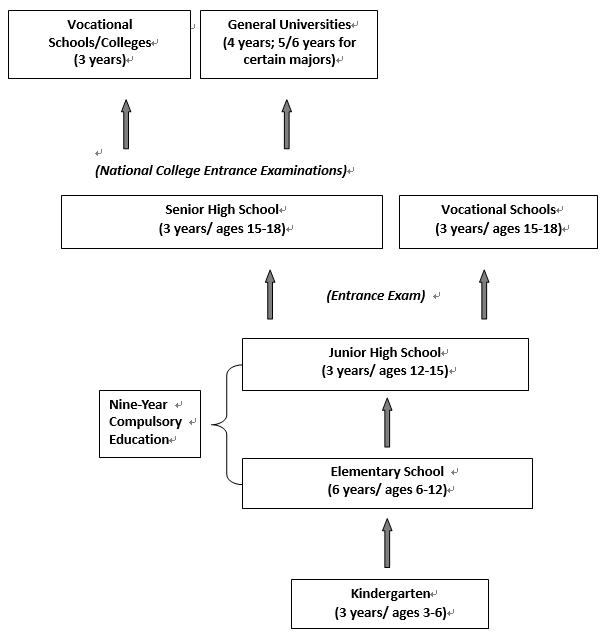The Chinese Educational System
Teaching in China means entering an entirely new educational system. This chapter will provide an overview of the school system in which you are about to teach. With regard to English teaching, the Chinese educational system has the following characteristics:
a) The centralized structure of authority.
b) The pivotal role of the written text.
c) The intellectual and moral authority of the teacher.
d) Skepticism about the trial and error aspects of the inquiry method of learning and about the focus on communicative activities emphasizing function rather than knowledge of form.
e) The over-arching functions of a prescribed national curriculum.
f) The authority of the national competitive examination system in political socialization, economic modernization and nation-building. (Tang & Absalom, 1998, p. 125)
Chinese Schools
Schools in China are mostly government-funded except a very small percentage of private schools. There are great differences in resource allocation and teaching quality between schools in the cities and in the countryside. Most colleges and universities cluster in big cities.
Stages of Schooling
The main stages of schooling in China include elementary, secondary (junior high school and senior high school), and higher education (college, university, vocational school). In 1987, the Chinese Peoples Congress passed the Universal and Compulsory Education Law that mandates that all children must receive nine years of schooling - six years of elementary school and three years of junior high school. Childrens schooling can begin at the age of two or three. They first go to day care for one year and then kindergarten for three years.
Completing kindergarten, students begin compulsory elementary school and junior high school. After graduating from junior high school, they study at senior high school for three more years before proceeding to colleges and universities.
Examinations play a very important role in the Chinese educational system. Various examinations - quizzes, unit tests, mid-terms, end-terms, final exams, graduation exams, school entrance exams - are frequently conducted as a measure of academic achievement and serve as the only criterion to get admission into higher level schools.
Exams and tests are believed to serve multiple purposes in education: a) to diagnose problems in teaching and learning in a timely manner, b) to motivate students to study continuously, c) to provide chances for students to review previously learned material, and d) gain fresh insights.
Stages of Schooling in China

Within the nine-year compulsory education, children are assigned to elementary and junior high schools according to where they live. But certain schools (schools with good facilities, high quality teachers, and demanding teaching and learning goals) admit students based on test scores. At the end of elementary school and again at the end of junior high schools, students take exams for positions in these high-quality schools. The exams to these schools are very competitive, but none can be compared to the National College Entrance Examination, the most important examination of all.
The National College Entrance Examination is a highly centralized testing system to select high school graduates for higher education and all universities and colleges recruit through it. The core subjects in the National College Entrance Examinations are Chinese, Math, and English. Successfully passing the exam and advancing to higher education is one of the most important achievements in a students academic career. This guarantees opportunities for a good job after graduation and automatically identifies one as part of the intellectual elite.
The Chinese School Year
A Chinese school year starts in early September and continues into the following July. It consists of two semesters: the fall semester and the spring semester. These two semesters have approximately 19-20 weeks respectively and are separated by a three-week winter break between January and February for the Spring Festival (Chinese New Year according to the Chinese lunar calendar) and a two-month summer vacation between July and September. The fall semester has a one-week break in the first week of October for the National Day (Chinas Independence Day) and the spring semester has a 5 day break in the first week of May for the International Labor Day.
Within these two semesters, schools are in session five days each week from 08:00 to 16:00 or 17:00. Students usually attend four or five classes in the morning and another two or three in the afternoon. Each class is 40 minutes long with a 10-minute break in between and the lunch break is approximately 60 to 90 minutes long, depending on the school.
From elementary up to high school, a class of students usually remains in their own classroom for regular classes except for music, P.E., art lessons and for labs. Teachers move from one classroom to another to teach their specialties. In general, students take different classes each day and only Chinese, Math, and English are taught every day. While most classes are required, students also take optional classes in the afternoon. There are no classes for reading because reading is taught in concert with other subjects, but students usually arrive at school before the first class in the morning begins to attend an activity called morning-reading, a 20-30 minute session in which students read the Chinese or English texts on their own or aloud after a peer or the recorded tape. Reading English aloud is believed to be helpful to develop the language sense and is widely practiced by Chinese students. Some schools also require students to attend self-study in the evening.
The Classroom
The class size in China is large, averaging 40-60 students. The seats in the classroom are usually arranged in rows and lines. Students in one class usually have a fixed chair and desk and they change their seats regularly. Colleges and universities have even larger classes, with 60-80 or even over a hundred students each. Classes for foreign language majors are usually much smaller, however, ranging from 20 to 35 students, sometimes even fewer. College students do not sit in appointed seats, but classroom seat arrangement remains the same.
Because of the large class size, the chairs and desks usually take up most of the space in a classroom. Sometimes you might even find unmovable seating in a university classroom because the back of the chair and the desk behind it are connected. As a result, it is usually very inconvenient to move the seats or to arrange them in a different way. Also, the teachers desk in front of the class is usually placed on a platform that stands slightly higher than the floor. Every classroom possesses at the very least a chalkboard. Overhead projectors, tape recorders and computers have become more and more common, but it is wise not to take them for granted. In most cases, the classroom is not air-conditioned, but usually has ceiling fans. Two basic requirements for a teacher are clear blackboard writing and speaking in a voice loud enough for every student to hear.









